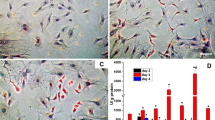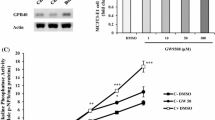Summary
Long-term treatment with an agonist of peroxisome proliferator-activated receptor (PPAR)-γ is associated with bone fractures in the clinical practice. However, the mechanisms underlying the fractures are not fully understood. This study was aimed to examine the effect of rosiglitazone (an agonist of PPAR-γ) of different doses on the proliferation, differentiation, and transforming growth factor beta 1 (TGF-β1)-induced expression of connective tissue growth factor (CTGF) in primary rat osteoblasts in vitro. Osteoblasts were isolated from newly born SD rats and treated with different doses of rosiglitazone (0–20 μmol/L). The proliferation and differentiation of osteoblasts were measured by MTT assay and NPP assay, respectively. The expression of CTGF was determined by RT-PCR and Western blotting. The results showed that most isolated osteoblasts displayed strong alkaline phosphatase (ALP) activity and treatment with different doses of rosiglitazone did not affect their proliferation, but significantly inhibited the differentiation of osteoblasts in a dose-dependent manner. Moreover, treatment with different doses of rosiglitazone significantly reduced the TGF-β1-induced CTGF mRNA transcription and protein expression in a dose-dependent manner in rat osteoblasts. It was concluded that the activation of PPAR-γ may inhibit the differentiation of osteoblasts by reducing the TGF-β1-induced CTGF expression in vitro.
Similar content being viewed by others
References
Selvamurugan N, Kwok S, Alliston T, et al. Transforming growth factor-beta 1 regulation of collagenase-3 expression in osteoblastic cells by cross-talk between the Smad and MAPK signaling pathways and their components, Smad2 and Runx2. J Biol Chem, 2004,279(18):19327–19334
Krishnaswami A, Ravi-Kumar S, Lewis JM. Thiazolidinediones: A 2010 perspective. Perm J, 2010,14(3):64–72
Newman AB, Kupelian V, Visser M, et al. Sarcopenia: alternative definitions and associations with lower extremity function. J Am Geriatr Soc, 2003,51(11):1602–1609
Broulik PD, Sefc L, Haluzik M. Effect of PPAR-gamma agonist rosiglitazone on bone mineral density and serum adipokines in C57BL/6 male mice. Folia Biol, 2011,57(4):133–138
Kawai M, Sousa KM, MacDougald OA, et al. The many facets of PPARgamma: novel insights for the skeleton. Am J Physiol Endocrinol Metab, 2010,299(1):E3–E9
Han JY, Kim YJ, Kim L, et al. PPARgamma agonist and angiotensin II receptor antagonist ameliorate renal tubulointerstitial fibrosis. J Korean Med Sci, 2010,25(1):35–41
Wu M, Melichian DS, Chang E, et al. Rosiglitazone abrogates bleomycin-induced scleroderma and blocks profibrotic responses through peroxisome proliferator-activated receptorgamma. Am J Pathol, 2009,174(2):519–533
Chen JR, Lazarenko OP, Wu X, et al. Obesity reduces bone density associated with activation of PPARgamma and suppression of Wnt/beta-catenin in rapidly growing male rats. PLoS One, 2010,5(10):e13704
Gonzalez CR, Matzkin ME, Frungieri MB, et al. Expression of the TGF-beta1 system in human testicular pathologies. Reprod Biol Endocrinol, 2010,8(1):148–159
Wei J, Ghosh AK, Sargent JL, et al. PPARgamma downregulation by TGFs in fibroblast and impaired expression and function in systemic sclerosis: a novel mechanism for progressive fibrogenesis. PloS One, 2010,5(11):e13778
Zhang GY, Cheng T, Zheng MH, et al. Activation of peroxisome proliferator-activated receptor-gamma inhibits transforming growth factor-beta1 induction of connective tissue growth factor and extracellular matrix in hypertrophic scar fibroblasts in vitro. J Lab Clin Med, 2009,301(1):515–522
Shi JQ, Xie M, Wang YJ, et al. The effect or rosiglitazone on signal pathways of transforming growth factor-beta1 in human lung fibroblast. Zhonghua Yan Ke Za Zhi (Chinese), 2008,44(5):413–417
Samarakoon R, Goppelt-Struebe M, Higgins PJ. Linking cell structure to gene regulation: signaling events and expression controls on the model genes PAI-1 and CTGF. Cell Signal, 2010,22(10):1413–1419
Sun K, Huang XH, Wang Q. Peroxisome proliferator-activated receptor gamma inhibits transforming growth factor beta1-induced connective tissue growth factor expression in rat hepatic stellate cells. J Bio Chem, 2009,29(49):45888–45894
Tan X, Dagher H, Hutton CA, et al. Effects of PPAR gamma ligands on TGF-beta1-induced epithelial-mesenhymal transition in alveolar epithelial cells. Respir Res, 2010,2(23):11–21
Gong K, Xing D, Li P, et al. Hypoxia induces downregulation of PPAR-gamma in isolated pulmonary arterial smooth muscle cells and in rat lung via transforming growth factor-beta signaling. AJP Lung Cel & Mol Physio, 2011,301(6):899–907
Max T, Randy A, Tiffany B, et al. Ets-1 is essential for connective tissue growth factor (CTGF/CCN2) induction by TGF-β1 in osteoblasts. PLoS one, 2012, 4(4):e35258
Han P, Ji WP, Zhao CL, et al. Improved osteoblast proliferation, differentiation and mineralization on nanophase Ti6Al4V. Chin Med J, 2011,124(2):273–279
Harslof T, Wamberg L, Moller L, et al. Rosiglitazone decreases bone mass and bone marrow fat. J Clin Endocrinol Metab, 2011,96(5):1541–1548
Bruedigam C, Eijken M, Koedam M, et al. A new concept underlying stem cell lineage skewing that explains the detrimental effects of thiazolidinediones on bone. Stem Cells, 2010,28(5):916–927
Rzonca SO, Suva LJ, Gaddy D, et al. Bone is a target for the antidiabetic compound rosiglitazone. Endocrinology, 2004, 145(1):401–406
Akune T, Ohba S, Kamekura S, et al. PPARgamma insufficiency enhances osteogenesis through osteoblast formation from bone marrow progenitors. J Clin Invest, 2004,113(6):846–855
Chen R, Xue J, Xie ML. Reduction of isoprenaline-induced myocardial TGF-beta1 expression and fibrosis in osthole-treated mice. Toxicol Appl Pharmacol, 2011, 256(2):168–173
Arnott JA, Zhang X, Sanjay A, et al. Molecular requirements for induction of CTGF expression by TGF-beta1 in primary osteoblasts. Bone, 2008,42(5):871–885
Ohyama Y, Tanaka T, Shimizu T, et al. Runx2/Smad3 complex negatively regulates TGF-beta-induced connective tissue growth factor gene expression in vascular smooth muscle cells. J Atheroscler Thromb, 2012,19(1):23–35
Zhang X, Arnott JA, Rehman S, et al. Src is a major signaling component for CTGF induction by TGF-beta1 in osteoblasts. J Cell Physiol, 2010,224(3):691–701
Wang L, Zhang X, Guo Y, et al. Involvement of BMPs/Smad signaling pathway in mechanical response in osteoblasts. Cell Physiol Biochem, 2010,26(6):1093–1102
Author information
Authors and Affiliations
Corresponding author
Additional information
This project was supported by the Natural Science Foundation of Hubei Province, China (No. 2010CDB09806).
Rights and permissions
About this article
Cite this article
Yu, Ww., Xia, Q., Wu, Y. et al. Activation of PPAR-γ inhibits differentiation of rat osteoblasts by reducing expression of connective tissue growth factor. J. Huazhong Univ. Sci. Technol. [Med. Sci.] 34, 652–656 (2014). https://doi.org/10.1007/s11596-014-1332-y
Received:
Revised:
Published:
Issue Date:
DOI: https://doi.org/10.1007/s11596-014-1332-y




